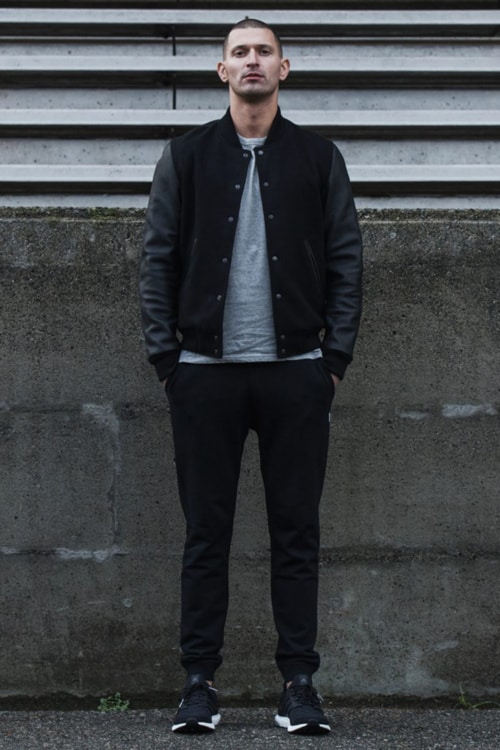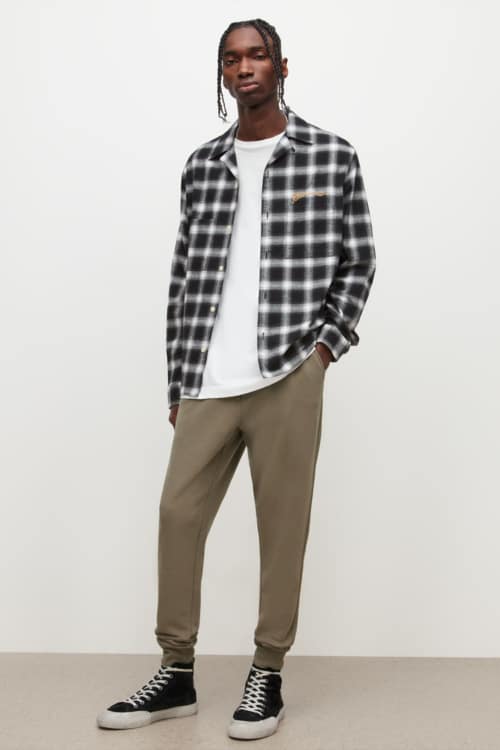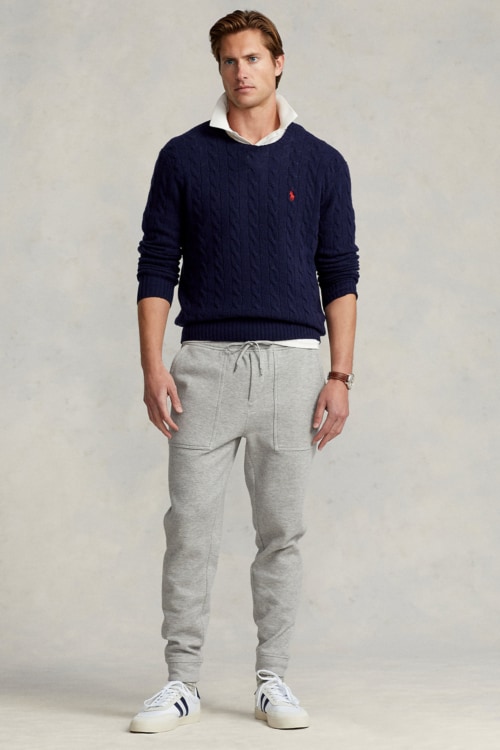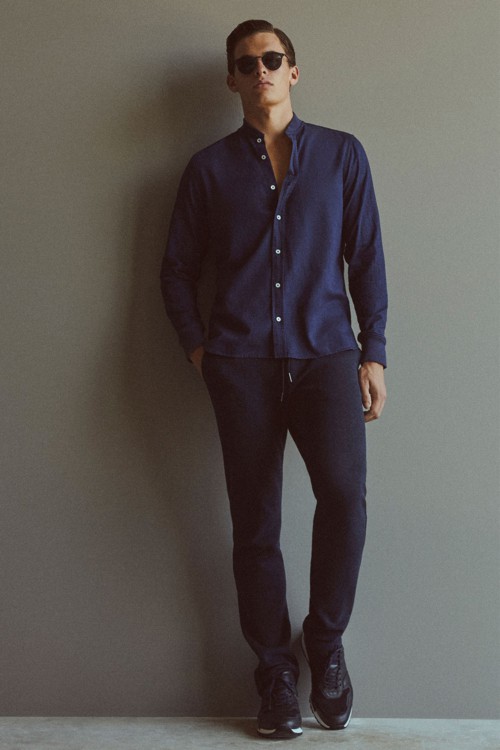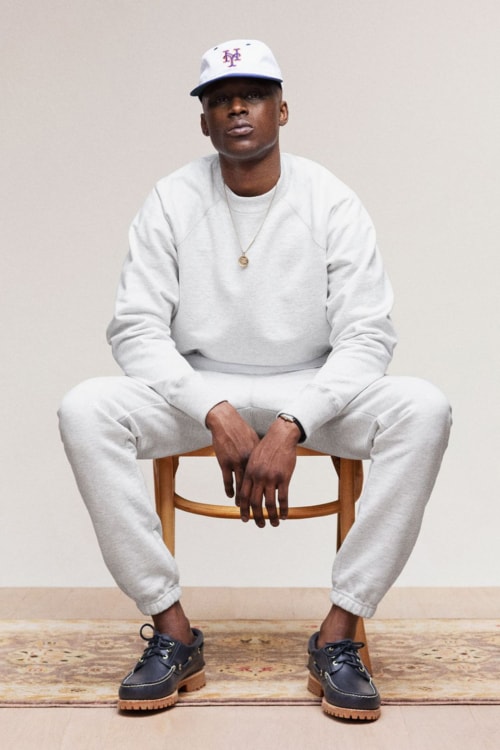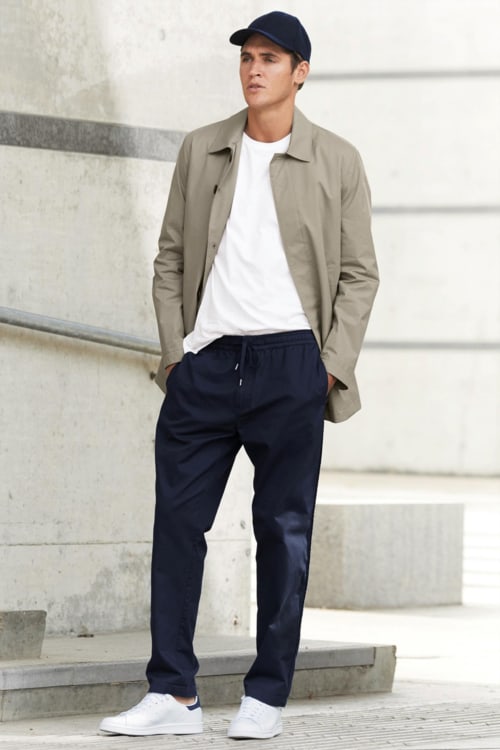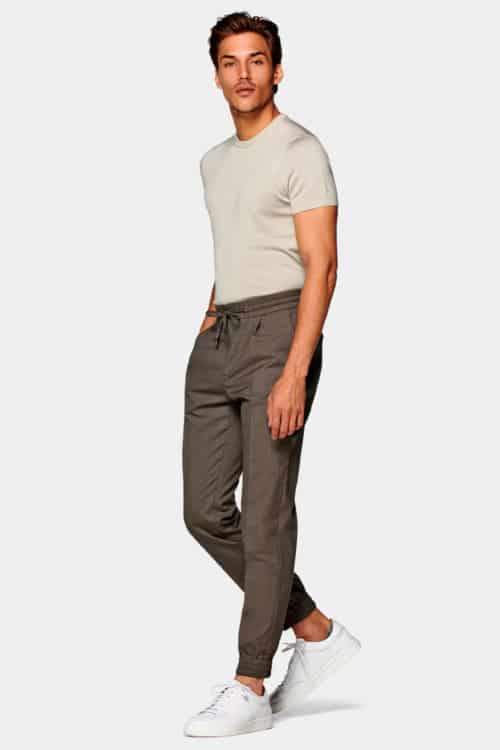
How To Style Sweatpants: 32 Outfits That Are Stylish, Not Sloppy
Sweatpants can be worn outside of the gym and the comfort of your own home, if you style them right.
What were once an occupation of the young, sporty or lazy, sweatpants are now an essential part of the modern wardrobe. The comfort they offer is unrivalled and, with pairs often cut in versatile fabrics and tailored fits, jogger pants today are more than just loungewear.
Here are eight contemporary ways you can wear sweatpants in 2024, including the details that will ensure you look stylish, not sloppy.
The best ways to wear sweatpants in 2024
With a cropped jacket/overshirt
This is arguably the coolest way to wear sweatpants today. It elevates them from their previous sporting associations into a genuine alternative to chinos or jeans, and one that’s infinitely more comfortable.
You need to pick the right pair of sweatpants though. An overshirt or cropped jacket leans smart casual, so your joggers need to be elevated to a similar level. Anything too relaxed, like a loose-fitting grey marl pair, would jar and make it look like you forget to pack your trousers after a gym session.
To get it right, start with the fabric: a quality cotton or wool blend in navy, black or charcoal is ideal as it gives the silhouette a more refined edge, making them appear more like dress pants or chinos. Next, ensure the fit is suitably tailored so you maintain a nice clean line down the leg.
Sweatpants such as these are easy to wear with denim jackets, chore coats, bombers and other smart casual staples like knitted polos, half-zip sweaters and more.
Streetwear joggers
Wearing sweatpants as part of a streetwear-inspired look is a natural fit. Their athletic heritage makes them ideal for combining with sneakers, hoodies, logo tees, baseball caps and other streetwear staples, all of which perfectly complement each other.
Yet while it seems obvious on paper, there are a number of different ways you can go about styling this look. One is to reference retro 90s LA grunge with a check shirt worn open over a white tee and canvas high tops. A pair of khaki sweatpants (see above) mimic chinos while offering a more relaxed, comfortable take on this laidback aesthetic.
Alternatively, you could go for a tonal approach, whether you opt for a head-to-toe black fit or a coordinating jogger and hoodie combination, finished with contrasting footwear and complementary coloured outerwear.
Keep it simple
As is so often the case in men’s fashion, less is more. This is no different with sweatpants, which depending on the style can easily become the focal point of an outfit.
When looking for your own pair, keep the extraneous detailing to a minimum and prioritise tapered versions in versatile, neutral shades. Think mid-rise, drawstring joggers in navy, black, stone or green.
Then, simply combine them with all your wardrobe basics: long-sleeved tops, plaint cotton tees, crew neck sweatshirts et al. There’s no need to overthink this – just ensure the colours are complementary and the fits are close (loose with loose; slim with slim) and you cannot go wrong.
Finish with sneakers and you have an everyday look that works for running errands or informal catch ups with friends.
Preppy sweatpants
While it might not be immediately obvious, sweatpants work well as part of a preppy look. Many collegiate staples are rooted in sport after all, including the polo shirt, Oxford button down, sneakers and sweatshirt. Jogger pants are a natural fit then, especially when cut from heritage fabrics like cotton jersey or wool.
Preppy style is vast and can be approached from a number of different angles. You can keep things simple by combining sweatpants with a solid or striped Oxford shirt and sneakers, or jazz it up slightly by throwing a cable knit sweatshirt or rain slicker over the top.
This is also a good chance to introduce some colour to your fit, considering how it’s a huge part of the Ivy League aesthetic. Primary reds, greens and yellows are always popular and work particularly well in the form of outerwear, while tonal shades of blue and navy reference preppy’s close associations with sailing and won’t have you straying too far out your comfort zone.
High-low dressing
High-low dressing is a fine art, and one that requires an astute eye. It’s essentially all about combining pieces that are typically formal or luxurious (high) with casual, off-duty pieces you wouldn’t usually think twice about (low). ‘High’ pieces include things like wool overcoats, sports jackets and cashmere jumpers, while ‘low’ items include sneakers, T-shirts, hoodies and our beloved sweatpants.
Combining these two types of clothing into one cohesive look is tricky as the juxtaposition can appear jarring if you get the balance wrong. But, when pulled off correctly, high-low dressing is one of the most powerful menswear moves you can make.
So, how to get it right? The first thing to consider is fit. If there’s a consistent fit between all your garments then chances are they will look more at home and as though combining them was intentional. Then there’s the colour palette. Sticking to a single base colour, such as tonal navy or grey, or earthy shades of stone, beige and off-white, essentially anchors the look, ensuring it appears deliberate and not like you got dressed in the dark.
Finally, keep things as simple as possible. Try teaming a pair of grey sweatpants with a slightly darker overcoat for example, layering a tonal grey knit and blue denim shirt underneath for a subtle pop of texture. Or, go even more minimal and combine navy tailored sweatpants with matching navy sneakers and a mid-blue flannel shirt for a luxurious take on weekend dressing.
Coords
A full tracksuit is not an easy look to pull off. You have to approach it with a certain amount of swagger, and even then you need to nail the details so you don’t risk looking like Del Boy on his day off, or Rocky Balboa.
To get it right, ensure the fit of the tracksuit is on point. It should be cut slim but with a bit of room to move, especially through the thigh and lower leg.
Then, consider your surrounding pieces. Try accessorising with a neck chain, bracelet, minimal watch or baseball cap to add a little individuality to what is essentially a coordinated top and bottom. Another tip is to wear a T-shirt under your sweatshirt and leave the hem poking out underneath, which adds a bit of depth to an otherwise very flat look. A similar effect can be had by layering polo shirt underneath, or by leaving your track jacket/hoodie unzipped.
Athleisure
Athleisure is a terrible portmanteau that references a vague dress code which combines athletic or performance garments with smart casual pieces. In the real world, this just means you can confidently combine your sweatpants with elevated sportswear staples like knitted polo shirts, quilted jackets and luxury sneakers.
However you choose to interpret the term – and there are myriad ways, as proven above – it demonstrates just how adaptable sweatpants are these days. Whether you opt for a classic grey marl pair or tailored wool drawstring trousers, jogger pants have come a long way since their humble beginnings on the American sports field.
Drawstring trouser alternative
This is where the lines get blurred. While not strictly sweatpants, drawstring trousers often feature all the distinguishing traits of them, from the elasticated waistband and hems to the slanted side pockets and stretchy, comfortable fabric.
However, it’s the latter that differentiates them. While sweatpants are traditionally made from cotton jersey, drawstring trousers are typically smarter, often crafted from cotton twill, linen blends or stretch wool, giving them an appearance that mimics regular tailored trousers.
Due to this, they’re much easier to wear as they aren’t pigeon-holed as sportswear. Therefore, use them as you would your favourite chinos and don’t think twice – they work with everything from tees and hoodies through to flannel shirts and bomber jackets and will quickly become your daily go-to.
Picking the right type of sweatpants
Fabric choice
Sweatpants have historically been made from cotton jersey. Originally designed for use on the American football field in the early 20th century, cotton jersey is woven with a plain front and a textured ‘loopback’ rear – named as such for the loops of fabric that were intended to draw sweat away from the body while allowing air to circulate through them, keeping the wearer cool during exercise.
While the technology has moved on today and cotton jersey is no longer considered a ‘performance’ fabric, it still has a place in the modern wardrobe. Incredibly comfortable thanks to its stretchy finish and soft handle, it’s ideal for loungewear like sweatpants and hoodies. Indeed, if you’re after a classic pair of jogger pants that reference mid-century athletics, this is the fabric to go for, especially in grey marl – the classic cotton jersey shade.
For something smarter and altogether more luxurious, consider wool and cashmere blends, which bring a sophisticated edge to an otherwise sporty design. Or try cotton twill as a best-of-both-worlds option, giving your sweat pants a smart casual feel that allows them to become a direct replacement for your jeans and chinos.
How they should fit
If you don’t pay close attention to the fit of your sweatpants, it’s all too easy for them to ruin your entire look. Too baggy and they’ll appear an afterthought; something you’ve just thrown on as you left the house in a hurry. Too slim on the other hand and you sacrifice comfort, negating the appeal of pulling on sweatpants in the first place.
For an ideal fit, aim for a slim, tapered cut. A mid-rise style that is tailored around the thigh (still with a bit of room) and tapers down to the ankle, finishing just above the shoes, is the most flattering for the majority of body shapes. A fit like this transforms sweatpants from a piece of loungewear into a modern-day wardrobe staple, and one that is suitable for a wide range of off-duty occasions.
Colour options
For the most versatile, time-honoured take on sweatpants, there are only three colours worth considering: grey, navy or black. Grey marl is the traditional shade and was used for decades as a performance garment worn by everyone from Muhammad Ali in the sparing ring to Steve McQueen in the gym. It references classic sportswear and is relatively easy to style: wear it with a black hoodie and your favourite pair of sneakers and you’ve got an old-school, training-style get-up that boasts plenty of street smarts.
For something actually smart though, you have to go navy or black. Easier to pass as regular trousers, especially if the fit is on point, these darker shades make sweatpants incredibly adaptable. They can be worn with tonal hoodies, tees or polos for an everyday casual look, or smartened up with an overshirt, chunky leather loafers/boat shoes and a cap for a smart casual fit that’s perfect for laid-back weekends.
